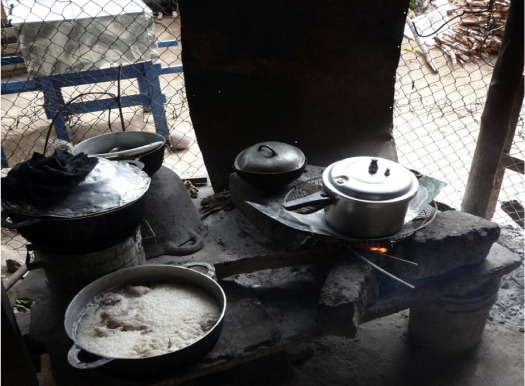Prevalence of Chronic Bronchitis and Respiratory Health Profile of a Population Exposed to Wood Smoke in Nicaragua.
IF 2.4
Q1 Medicine
Journal of Health and Pollution
Pub Date : 2020-05-26
eCollection Date: 2020-06-01
DOI:10.5696/2156-9614-10.26.200607
引用次数: 3
Abstract
Background. Household air pollution (HAP) is one of the most important environmental risk factors worldwide associated with chronic respiratory diseases. Objectives. The present study focused on respiratory health in a population with high wood smoke exposure in Nicaragua. Methods. We employed a cross-sectional study with 213 participants. Data on the prevalence of chronic bronchitis (chronic bronchitis), chronic obstructive pulmonary disease (COPD) and asthma, including respiratory scores and pulmonary function tests, were documented. The role of risk factors for chronic bronchitis was analyzed. Results. We found a high prevalence of chronic airway diseases in the population exposed to wood smoke. A higher prevalence of chronic bronchitis was found in persons serving as primary cooks in households. Further confounding factors for chronic bronchitis included age, a prior diagnosis of asthma, inhalational allergies and lower socioeconomic status. Respiratory scores were elevated in individuals with chronic bronchitis. Conclusions. This is one of the first studies in a wood smoke-exposed population in Nicaragua showing a high prevalence of chronic bronchitis and COPD with an emphasis on the analysis of personal and environmental risk factors. Further studies are needed to address which combination of interventions is most efficient for ameliorating respiratory health hazards. Participant Consent. Obtained Ethics Approval. The study protocol was approved by the Ethics Committee of the University of Luebeck, Germany (reference number 12-214), and by the Ethics Committee of the Department of Medical Sciences at National Autonomous University of Nicaragua, Managua, Nicaragua. Competing Interests. The authors declare no competing financial interests.

尼加拉瓜木材烟雾暴露人群慢性支气管炎患病率和呼吸系统健康状况
背景:家庭空气污染(HAP)是世界范围内与慢性呼吸系统疾病相关的最重要的环境危险因素之一。目的:本研究的重点是尼加拉瓜高木材烟雾暴露人群的呼吸健康。方法:采用横断面研究,共213名受试者。记录了慢性支气管炎(慢性支气管炎)、慢性阻塞性肺疾病(COPD)和哮喘患病率的数据,包括呼吸评分和肺功能测试。分析慢性支气管炎危险因素的作用。结果:我们发现在暴露于木材烟雾的人群中,慢性呼吸道疾病的患病率很高。在家庭中担任主要厨师的人中发现慢性支气管炎的患病率较高。慢性支气管炎的其他混淆因素包括年龄、先前的哮喘诊断、吸入性过敏和较低的社会经济地位。慢性支气管炎患者的呼吸评分升高。结论:这是在尼加拉瓜木材烟雾暴露人群中进行的首批研究之一,显示慢性支气管炎和慢性阻塞性肺病的高患病率,重点分析了个人和环境风险因素。需要进一步研究哪种干预措施组合最有效地减轻呼吸道健康危害。参与者同意:已获取。伦理批准:研究方案得到了德国吕贝克大学伦理委员会(参考编号12-214)和尼加拉瓜马那瓜尼加拉瓜国立自治大学医学系伦理委员会的批准。利益竞争:作者声明没有经济利益竞争。
本文章由计算机程序翻译,如有差异,请以英文原文为准。
求助全文
约1分钟内获得全文
求助全文
来源期刊

Journal of Health and Pollution
Medicine-Public Health, Environmental and Occupational Health
自引率
0.00%
发文量
0
审稿时长
18 weeks
期刊介绍:
The Journal of Health and Pollution (JH&P) was initiated with funding from the European Union and World Bank and continues to be a Platinum Open Access Journal. There are no publication or viewing charges. That is, there are no charges to readers or authors. Upon peer-review and acceptance, all articles are made available online. The high-ranking editorial board is comprised of active members who participate in JH&P submissions and editorial policies. The Journal of Health and Pollution welcomes manuscripts based on original research as well as findings from re-interpretation and examination of existing data. JH&P focuses on point source pollution, related health impacts, environmental control and remediation technology. JH&P also has an interest in ambient and indoor pollution. Pollutants of particular interest include heavy metals, pesticides, radionuclides, dioxins, polychlorinated biphenyls (PCBs), polycyclic aromatic hydrocarbons (PAHs), volatile organic compounds (VOCs), air particulates (PM10 and PM2.5), and other severe and persistent toxins. JH&P emphasizes work relating directly to low and middle-income countries, however relevant work relating to high-income countries will be considered on a case-by-case basis.
 求助内容:
求助内容: 应助结果提醒方式:
应助结果提醒方式:


